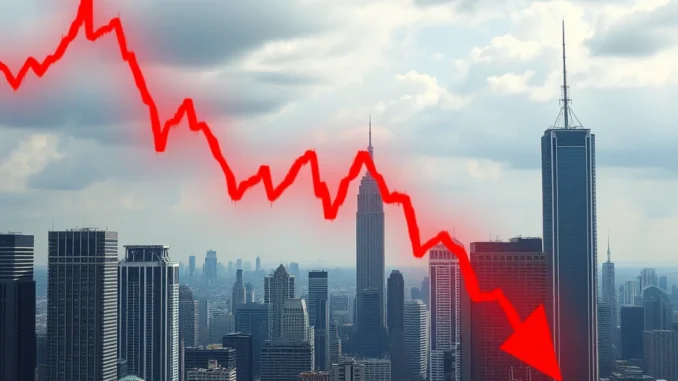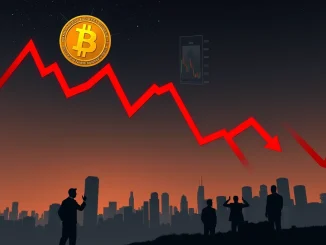
Buckle up, investors! If you thought the crypto market was volatile, yesterday’s U.S. stock market session sent shockwaves through traditional finance. Major indexes took a nosedive, painting a sea of red across portfolios. Let’s dive into what triggered this dramatic stock market crash and what it means for you.
Decoding the Stock Market Decline: A Sea of Red on Wall Street
It was a day investors won’t soon forget. All three major U.S. stock indexes – the S&P 500, Nasdaq Composite, and Dow Jones Industrial Average – closed sharply lower, signaling a broad and significant stock market decline. The numbers speak for themselves:
- S&P 500: Plummeted by a staggering 2.70%.
- Nasdaq Composite: Suffered the most, crashing down by a painful 4.00%.
- Dow Jones Industrial Average: Wasn’t spared either, dropping by a significant 2.08%.
These aren’t just numbers; they represent billions of dollars wiped off the market in a single trading day. But what exactly fueled this sudden market downturn? While pinpointing a single cause is always complex, several factors likely contributed to the sell-off:
- Inflation Fears Persist: Concerns about persistent inflation continue to weigh heavily on investor sentiment. Strong economic data, while seemingly positive, can be interpreted as fuel for further inflationary pressures, leading to expectations of more aggressive interest rate hikes by the Federal Reserve.
- Interest Rate Hike Jitters: The market is highly sensitive to signals from the Federal Reserve regarding interest rate policy. Any hint of a more hawkish stance – meaning faster or larger rate increases – tends to spook investors, as higher rates can slow economic growth and increase borrowing costs for companies.
- Geopolitical Uncertainty: Global events always play a role. Ongoing geopolitical tensions and uncertainties can add to market volatility and risk aversion.
- Profit Taking and Technical Corrections: After periods of gains, markets are prone to corrections. Investors may have decided to take profits, contributing to the downward pressure. Furthermore, technical factors and algorithmic trading can amplify market movements.
S&P 500: A Broad Market Barometer Takes a Hit
The S&P 500, often considered the best overall representation of the U.S. stock market, experienced a significant drop of 2.70%. This broad-based index includes 500 of the largest publicly traded companies in the United States, making its performance a key indicator of the market’s health. The across-the-board selling pressure in the S&P 500 suggests that the concerns were widespread, impacting various sectors of the economy.

[caption]S&P 500 Index Performance – Recent Trends
[/caption]
Nasdaq’s Tech Wreck: Innovation Stocks Lead the Decline
The technology-heavy Nasdaq Composite bore the brunt of the selling, plummeting by a dramatic 4.00%. Growth stocks, particularly in the tech sector, are often more sensitive to interest rate hikes. This is because their valuations are often based on future earnings, which are discounted more heavily when interest rates rise. The sharp decline in the Nasdaq highlights the market’s current aversion to risk and its heightened sensitivity to interest rate expectations. Major tech giants, which carry significant weight in the Nasdaq, all experienced substantial losses, further dragging down the index.
Dow Jones: Blue-Chip Stocks Not Immune to the Downturn
Even the Dow Jones Industrial Average, known for its more established and often considered ‘safer’ blue-chip stocks, wasn’t immune to the negative sentiment. It fell by 2.08%, demonstrating that the market downturn was not confined to specific sectors but rather a broad market phenomenon. While the Dow’s percentage drop was slightly less than the S&P 500 and Nasdaq, its significant point drop still represents a substantial loss in value. This indicates that even traditionally stable, dividend-paying stocks are feeling the pressure from the current economic and market uncertainties.
Navigating the Market Downturn: Actionable Insights for Investors
So, what should investors do in the face of this market downturn? Panic selling is rarely a wise strategy. Instead, consider these actionable steps:
- Stay Calm and Don’t Panic: Market corrections are a normal part of the investment cycle. Emotional reactions can lead to poor decisions.
- Review Your Portfolio: Assess your portfolio’s risk level and diversification. Is it aligned with your long-term financial goals and risk tolerance?
- Consider Dollar-Cost Averaging: If you have cash to invest, consider dollar-cost averaging – investing a fixed amount of money at regular intervals – to mitigate the risk of buying at market peaks.
- Focus on the Long Term: Remember that investing is a long-term game. Market downturns can present buying opportunities for patient investors with a long-term perspective.
- Seek Professional Advice: If you’re unsure how to navigate the current market environment, consult with a qualified financial advisor.
Urgent Market Summary: Key Takeaways from the Sell-Off
Yesterday’s sharp decline in the major U.S. stock indexes serves as a stark reminder of market volatility and the various factors that can influence investor sentiment. The stock market crash, while concerning, also presents opportunities for strategic investors. Understanding the reasons behind the stock market decline and adopting a calm, long-term perspective are crucial for navigating these turbulent times. Keep a close eye on market developments and be prepared for continued volatility as the market digests economic data and Federal Reserve policy signals. This market downturn is a moment to reassess, rebalance, and reaffirm your investment strategy for the long haul.



